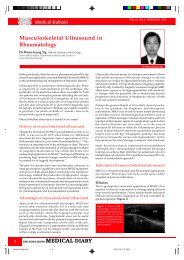Dermatology - 香港醫學組織聯會
Dermatology - 香港醫學組織聯會
Dermatology - 香港醫學組織聯會
You also want an ePaper? Increase the reach of your titles
YUMPU automatically turns print PDFs into web optimized ePapers that Google loves.
VOL.15 NO.11 NOVEMBER 2010<br />
Common Superficial Fungal Infections –<br />
a Short Review<br />
Dr. King-man HO<br />
MBBS (HK), MRCP (UK), FHKCP, FHKAM (Medicine), FRCP (Glasgow, Edin),<br />
Dip Derm (London), Dip GUM (LAS)<br />
Consultant Dermatologist, Social Hygiene Service, CHP<br />
Specialist in <strong>Dermatology</strong> and Venereology<br />
Dr. Tin-sik CHENG<br />
MB, MPhil, MRCP, FHKCP, FHKAM (Medicine)<br />
Clinical Assistant Professor (Hon), <strong>Dermatology</strong> Research Centre,<br />
Faculty of Medicine, the Chinese University of Hong Kong<br />
Specialist in <strong>Dermatology</strong> and Venereology<br />
Introduction<br />
Superficial fungal infections of the skin are among<br />
the most common diseases seen in our daily practice.<br />
These infections affect the outer layers of the skin,<br />
the nails and hair. In contrary to many of the other<br />
infections affecting the other organ systems in humans,<br />
the fungi may cause dermatological conditions that<br />
do not involve tissue invasion. On the other hand, the<br />
skin surface is the habitat of some of these fungi and is<br />
liable to environmental contamination. Therefore, mere<br />
isolation of these organisms from clinical specimens<br />
taken from the skin surface is not a sine qua non of their<br />
role in the disease causation. The main groups of fungi<br />
causing superficial fungal infections are dermatophytes,<br />
yeasts and moulds.<br />
The dermatophytes that usually cause only superficial<br />
infections of the skin are grouped into three genera:<br />
Microsporum, Trichophyton, and Epidermophyton. They<br />
can be classified into three groups according to their<br />
normal habitats: 1) humans: anthropophilic species<br />
2) animals: zoophilic species 3) soil: geophilic species.<br />
Dermatophytes grow on keratin and therefore cause<br />
diseases in body sites wherein keratin is present. These<br />
sites include the skin surface, hair and nail. Presence<br />
of hyperkeratosis such as palmoplantar keratoderma<br />
predisposes to dermatophyte infections. Trichophyton<br />
rubrum is the most common cause worldwide for<br />
superficial dermatophytosis.<br />
Yeasts are not inherently pathogenic, but when the<br />
host's cellular defences, skin function, or normal flora<br />
are altered, colonisation, infection, and disease can<br />
occur. Candida is a normal inhabitant of the oropharynx,<br />
gastrointestinal tract and vagina in some people. Moist,<br />
wet conditions favour Candida overgrowth and can lead<br />
to superficial infections of the skin. Candida albicans is the<br />
most virulent of these organisms, and may cause diseases<br />
of the skin, nails, mucous membranes and viscera.<br />
The yeast Malassezia furfur, a skin commensal, can cause<br />
pityriasis versicolor and pityrosporum folliculitis. The<br />
fungus is also related to seborrhoeic dermatitis though<br />
true infection is not present and its presence on the skin<br />
is not a sufficient condition for disease expression. The<br />
presence of oil facilitates the growth of this organism.<br />
Moulds that are also referred as nondermatophyte<br />
filamentous fungi are ubiquitous in the environment<br />
but are not commonly pathogenic in normal hosts. They<br />
are however not uncommonly isolated from clinical<br />
specimens for fungal culture. Most of the time, they can<br />
Medical Bulletin<br />
Dr. King-man HO<br />
Dr. Tin-sik CHENG<br />
be regarded as innocent bystanders or contaminants.<br />
These organisms sometimes however may have roles in<br />
disease causation.<br />
Diseases Caused by Dermatophytes<br />
Species from the genera Epidermophyton, Microsporum<br />
and Trichophyton are most commonly involved. Species<br />
from the genera Epidermophyton species affect nails<br />
and skin, Microsporum species affect hair and skin<br />
while Trichophyton species affect hair, nails and skin.<br />
Dermatophyte infections are subclassified in Latin names<br />
according to the sites of skin involved, e.g. tinea faciei:<br />
face; tinea manuum: hands; tinea corporis: glabrous<br />
skin, tinea cruris: crural folds; tinea pedis: feet; tinea<br />
capitis: scalp; tinea unguium: nails. Infections involving<br />
more than one site of the integument is not uncommon.<br />
It is an axiom to look for infections of other sites when<br />
dermatophytosis is found in any one of these sites.<br />
Tinea Corporis and Variants<br />
Tinea corporis, the classic 'ringworm', is a dermatophyte<br />
infection of the glabrous skin of the trunk and extremities.<br />
Common causes are T. rubrum and T. mentagrophytes.<br />
The typical lesions are pink-to-red annular or arciform<br />
patches and plaques with scaly or vesicular borders that<br />
expand peripherally with a tendency for central clearing.<br />
Inflammatory follicular papules may be present at the<br />
active border. Sometimes, when the follicular epithelium<br />
is grossly involved resulting in folliculitis, it is known as<br />
Majocchi’s granuloma.<br />
Topical steroids are often prescribed for skin rash.<br />
Sometimes, they are wrongly prescribed for tinea. The<br />
presentations of the fungal infections are changed as<br />
the inflammatory response is decreased leading to the<br />
condition known as tinea incognito. The well defined<br />
margins and scaling may be absent while diffuse<br />
erythema and scales, papules and pustules may be found.<br />
When the face is affected, it is called tinea faciei. The<br />
typical annular lesions with peripheral scaling are<br />
frequently absent. The clinical clue is the presence of<br />
red borders which are faintly demarcated, serpiginous<br />
and involving only one side of the face.<br />
Tinea Pedis<br />
Tinea pedis occurs in four main patterns: interdigital,<br />
moccasin, ulcerative and vesiculobullous. In the<br />
interdigital type, erythema, scaling and maceration with<br />
23
















